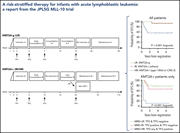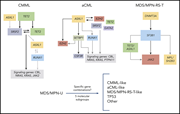Issue Archive
Table of Contents
BLOOD COMMENTARIES
HOW I TREAT
How I treat relapsed acute lymphoblastic leukemia in the pediatric population
Although 85% of pediatric patients with ALL have long-term remission following chemotherapy, the prognosis of relapsed ALL remains poor. Hunger and Raetz use multiple scenarios involving 3 illustrative patients to highlight advances in therapy for relapsed ALL and discuss appropriate sequencing of hematopoietic stem cell transplantation and novel immunotherapies.
CLINICAL TRIALS AND OBSERVATIONS
A risk-stratified therapy for infants with acute lymphoblastic leukemia: a report from the JPLSG MLL-10 trial
CME
Clinical Trials & Observations
Infant acute lymphoblastic leukemia (ALL) has a particularly poor prognosis, especially when associated with KMT2A gene rearrangement (KMT2A-r). The authors report on a risk-stratified approach to infants with ALL, restricting hematopoietic cell transplantation to high-risk patients. Using this strategy, they found that intermediate-risk patients, despite having KMT2A-r+ ALL, have outcomes similar to those of low-risk patients, although improved approaches are still needed for high-risk patients.
HEMATOPOIESIS AND STEM CELLS
Yap1-Scribble polarization is required for hematopoietic stem cell division and fate
The determination of hematopoietic stem cell fate depends on microenvironmental cues that regulate self renewal vs differentiation depending on changes in cellular polarity. The authors outline a complex regulatory pathway governing this process, with implications for hematopoietic stress response and potential hematopoietic stem cell expansion.
LYMPHOID NEOPLASIA
Tumor-associated myeloid cells provide critical support for T-ALL
Lyu et al investigated the role of the microenvironment in T-cell ALL (T-ALL), demonstrating that monocyte-macrophages are necessary for supporting the survival and proliferation of T-ALL cells in vitro and in vivo in murine models. In addition, they demonstrated that an enriched macrophage signature in human pediatric T-ALL is associated with inferior outcomes, suggesting that tumor-associated myeloid cells might offer a novel target for T-ALL therapy.
MYELOID NEOPLASIA
Molecular landscape and clonal architecture of adult myelodysplastic/myeloproliferative neoplasms
Myelodysplastic/myeloproliferative (MDS/MPN) neoplasms are a heterogeneous set of syndromes, including chronic myelomonocytic leukemia, atypical chronic myeloid leukemia, MDS/MPN with ring sideroblasts and thrombocytosis, and MDS/MPN unclassifiable (MDS/MPN-U). Using genome-wide sequencing, the authors defined gene signatures underlying genotype-phenotype associations and demonstrated that many patients with MDS/MPN-U have signatures that mimic other subtypes.
THROMBOSIS AND HEMOSTASIS
Plasma levels of growth differentiation factor 15 are associated with future risk of venous thromboembolism
Growth differentiation factor 15 (GDF-15) is elevated in inflammation and a biomarker for arterial cardiovascular disease. The authors examined the association between GDF-15 and venous thromboembolism (VTE). They demonstrated that elevated plasma levels of GDF-15 are associated with increased VTE risk, with Mendelian randomization suggesting that it is a biomarker of potential VTE risk but not causal.
VASCULAR BIOLOGY
VEGF-C protects the integrity of the bone marrow perivascular niche in mice
The bone marrow stem cell niche is critical for hematopoietic stem cell development. The authors demonstrate that vascular endothelial growth factor C (VEGF-C) is critical for maintaining the niche: elimination of VEGF-C leads to delayed hematopoietic recovery posttransplant, and exogenous VEGF-C accelerates hematopoietic recovery from irradiation.
LETTERS TO BLOOD
Reevaluation of excessive erythrocytosis in diagnosing chronic mountain sickness in men from the world’s highest city
The diagnosis of chronic mountain sickness (CMS) is based on a score including 7 clinical features (breathlessness, sleep disturbance, cyanosis, venous dilatation, paresthesia, headache, and tinnitus) in the setting of extreme erythrocytosis. Examining individuals in La Rinconada, Peru, the highest city in the world, the authors demonstrated that CMS at extreme altitude is not linked to elevation of hemoglobin, since CMS+ and CMS− individuals had similar levels of erythrocytosis.
No evidence of SARS-CoV-2 transfusion transmission despite RNA detection in blood donors showing symptoms after donation
Clinical Trials & Observations
The risk of transfusion-associated transmission of SARS-CoV-2 is unknown. Cappy and colleagues report on hemovigilance studies of 268 blood donations from individuals reporting symptoms shortly after donation. Of 268 samples, 3 tested positive for viral RNA, of which 1 had components that were transfused before testing; no cases of transfusion-documented transmission were seen.
BLOOD WORK
CONTINUING MEDICAL EDUCATION (CME) QUESTIONS
-
Cover Image
Cover Image
![issue cover]()
Immunofluorescence image of the spleen from a mouse with T-cell acute lymphoblastic leukemia (T-ALL). Tumor-associated myeloid cells (F4/80+ in red, CD11c+ in magenta) colocalize with T-ALL cells (green) and provide signals to directly support disease progression. See the article by Lyu et al on page 1837.
- PDF Icon Front MatterFront Matter
- PDF Icon Table of ContentsTable of Contents
- PDF Icon Back MatterBack Matter
- PDF Icon Editorial BoardEditorial Board
Advertisement intended for health care professionals
Email alerts
Advertisement intended for health care professionals










Intensive but tender care for infant ALL
Clinical Trials & Observations